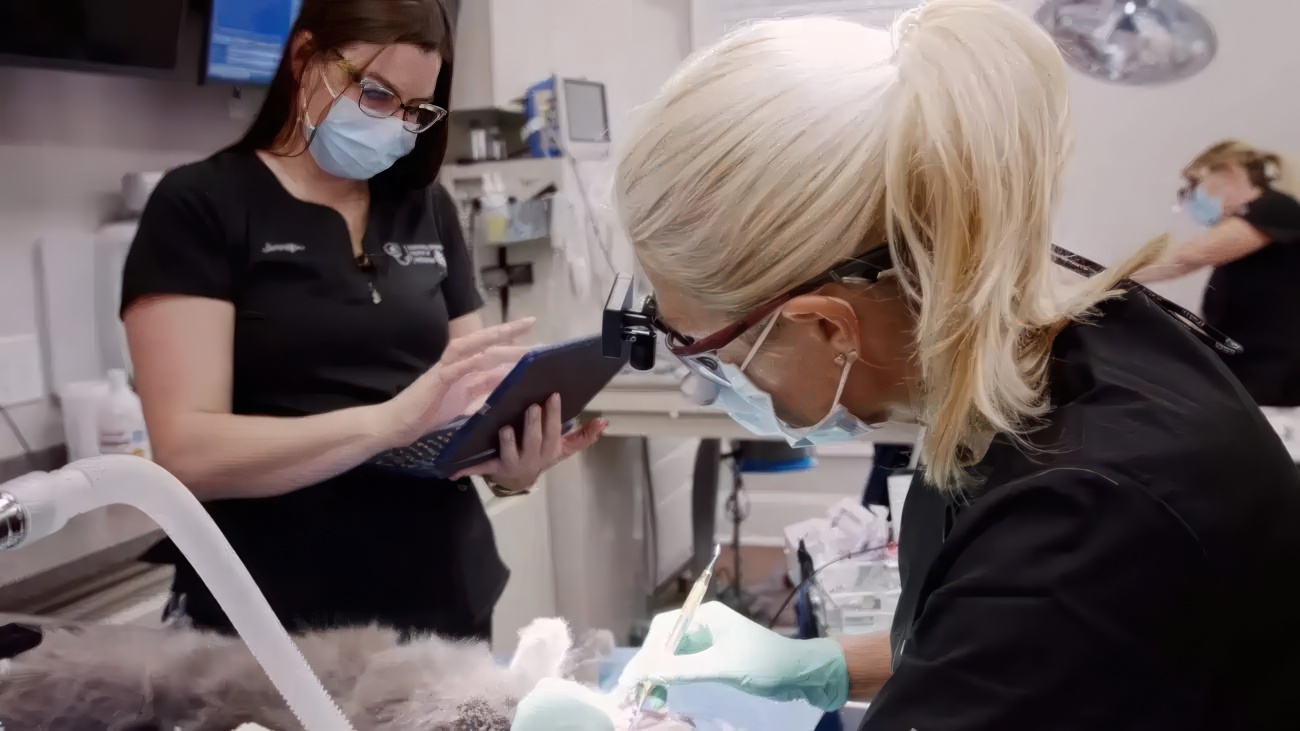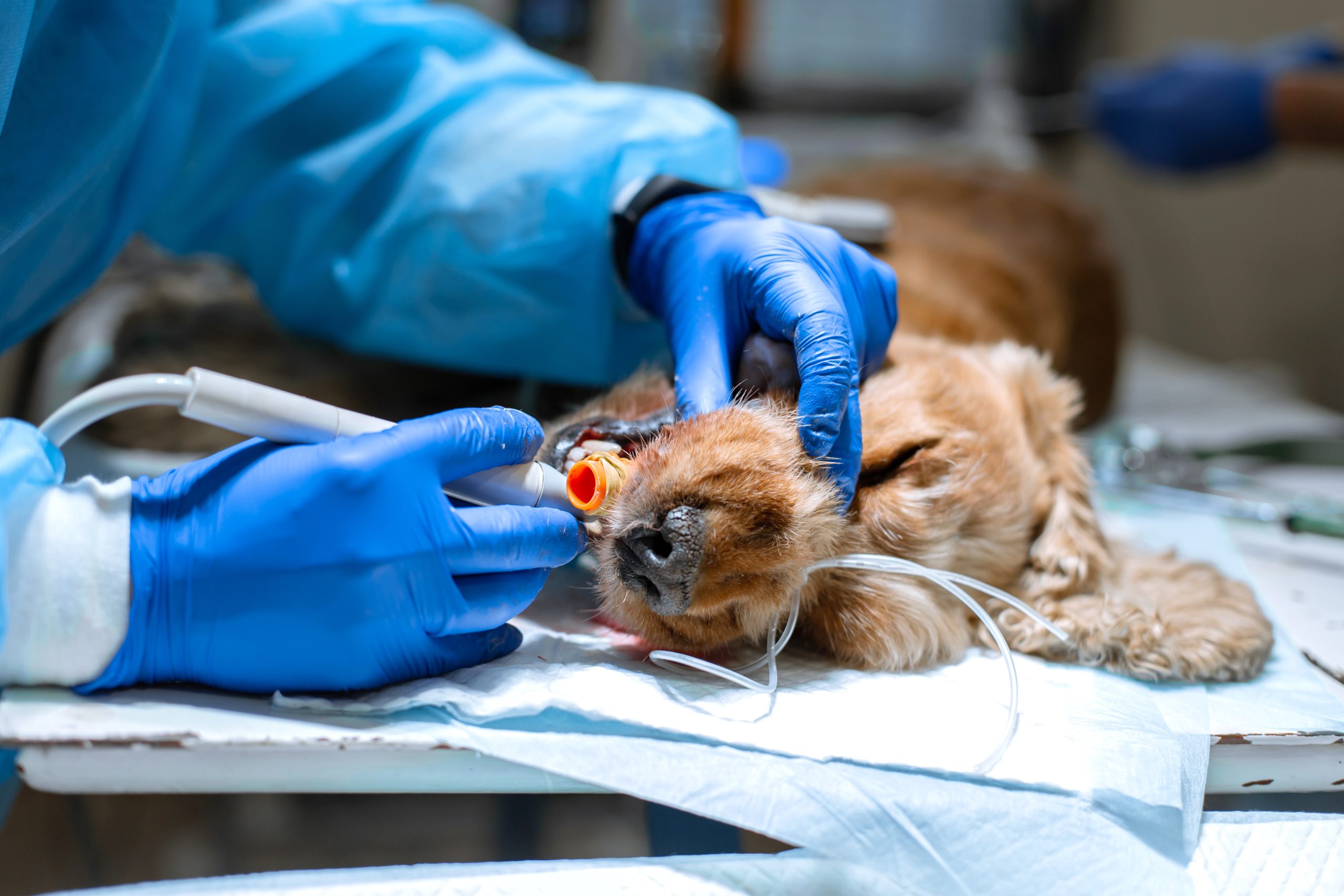Debunking Fears and Ensuring Safety about Pet Anesthesia
Did you know that poor dental health can lead to serious health issues in pets? Pet dental health is a crucial yet often overlooked aspect of overall well-being. While professional dental cleanings and treatments are essential, many pet owners hesitate due to concerns about pet anesthesia.
At the Veterinary Dental Center of Atlanta, we prioritize both dental excellence and safety. Our team of highly trained and experienced veterinary dental providers brings years of experience to every procedure, ensuring your beloved companion receives the care they need without unnecessary risks. We’ve designed our anesthesia protocols to keep your pets comfortable and secure while addressing the dental issues that could silently affect their quality of life.
Understanding Anesthesia in Pet Dentistry
What is Pet Anesthesia?
Anesthesia is a carefully managed process that helps pets stay calm and pain-free during dental procedures. It allows veterinarians to work safely without causing stress or discomfort. It is especially vital in dental treatments, where precision and control are necessary.
Types of Anesthesia Used in Pet Dentistry
- General anesthesia: Induces complete unconsciousness, ensuring the pet remains still and pain-free.
- Local anesthesia: Numbs specific areas of the mouth for minor dental procedures.
- Sedation options: Mild sedatives can be used to calm anxious pets before anesthesia.
Common Dental Procedures Requiring Anesthesia
- Dental cleanings: Thorough cleaning under the gumline to prevent periodontal disease.
- Tooth extractions: Necessary for severely damaged or infected teeth.
- Oral surgeries: Corrective or reparative surgeries requiring precise intervention.
Debunking Common Pet Anesthesia Myths & Fears
Myth 1: Anesthesia is Unnecessary for Dental Cleaning
Conscious dental cleanings may seem safer, but they are ineffective and unsafe. Without anesthesia, veterinarians cannot clean below the gumline or treat hidden dental issues, which are often the root of oral health problems.
Myth 2: Anesthesia is Too Risky for Older Pets
Research reveals that older pets have remarkable success rates when veterinarians conduct thorough pre-procedure assessments. In fact, clinics following modern safety protocols report an impressive 99% success rate for senior pets under anesthesia.
At VDCA, we customize anesthesia plans for your companion’s unique health needs, making necessary procedures safer than ever. Don’t let age alone keep your senior pet from getting the care they deserve!
Myth 3: Pets Don’t Wake Up from Anesthesia
Anesthesia-related fatalities are extremely rare in healthy pets. Modern recovery protocols ensure pets awaken gradually under careful supervision, minimizing risks.
Myth 4: Anesthesia Causes Long-Term Side Effects
The vast majority of pets bounce back from anesthesia without any permanent effects. Modern anesthetic agents are designed to metabolize quickly, allowing your pet to return to normal within hours or days. Your veterinarian will equip you with detailed recovery guidelines. From monitoring activity levels to managing pain, you can ensure your furry friend returns to their playful self quickly.
Ensuring Anesthesia Safety for Your Pet
Pre-Anesthesia Assessments
Veterinarians conduct comprehensive evaluations before anesthesia:
- Physical exams to assess overall health.
- Bloodwork and diagnostic tests to identify potential risks.
- Reviewing medical history to customize anesthesia plans.
Advanced Monitoring During Procedures
While under anesthesia, pets are closely monitored using advanced equipment to track:
- Oxygen levels
- Heart rate and respiratory status
- Body temperature regulation
Post-Procedure Recovery and Care
Following dental treatments:
- Pets are closely observed as they wake up.
- Veterinarians provide aftercare instructions to ensure a smooth recovery.
- Pet owners are advised to monitor behavior and appetite during the recovery period.
Importance of Experienced Anesthesia Technicians
Qualified veterinary technicians ensure pets remain stable and safe during anesthesia. Their training in monitoring equipment and immediate intervention protocols reduces potential risks.

Tips for Pet Owners to Ease Anesthesia Concerns
Asking the Right Questions
Before scheduling your pet’s dental procedure, consider asking your veterinarian:
- What steps are taken to ensure my pet’s safety during pet anesthesia?
- Are pre-anesthesia screenings performed?
- Who will monitor my pet throughout the procedure?
Understanding Risk Factors
While anesthesia has inherent risks, healthy pets undergoing proper screening are at minimal risk. Discussing these factors with your vet ensures informed decisions.
Preparing Your Pet for Anesthesia
To minimize complications:
- Follow your vet’s fasting instructions. Fasting reduces the risk of vomiting during anesthesia, which can cause serious complications.
- Ensure your pet remains calm before the procedure.
The Benefits of Anesthetized Dental Procedures
Improved Oral Health and Longevity
Anesthesia allows veterinarians to perform a comprehensive cleaning, reducing plaque, tartar, and potential infections that can affect major organs.
Reduced Pain and Discomfort for Pets
Anesthesia ensures pets experience no pain during dental procedures, minimizing stress and fear.
Early Detection of Dental Issues
Comprehensive exams, including diagnostic dental radiographs during dental procedures, enable early identification and treatment of emerging dental problems, improving long-term health outcomes.
Anesthesia in pet dentistry is a safe and necessary procedure that ensures optimal dental care. Pet owners can confidently schedule dental treatments by following modern safety protocols and choosing experienced veterinary professionals, improving their pets’ health and well-being.
FAQs
- Is anesthesia always necessary for pet dental cleanings? Yes, anesthesia is essential for thorough cleanings, particularly for cleaning below the gumline and taking diagnostic dental radiographs.
- What precautions are taken to ensure my pet’s safety during anesthesia? Veterinarians conduct pre-anesthesia screenings, provide customized protocols, and monitor pets throughout the procedure.
- How long does it take for pets to recover from anesthesia? Most pets recover within 12 to 24 hours, although mild grogginess may persist temporarily.
- Are there special considerations for senior pets undergoing anesthesia? Veterinarians may recommend additional screening tests and customized protocols for senior pets.
- What are the signs of dental problems that pet owners should watch for? Common signs include bad breath, swollen gums, difficulty eating, and pawing at the mouth. Regular dental checkups can prevent these issues.
Talk to Your Veterinarian
If you suspect your cat or dog has a malocclusion, don’t wait. Early detection and treatment can prevent pain and complications. A happy mouth makes for a happy pet!
Schedule a dental check-up today to keep your pet smiling with fresh breath and pearly whites!

